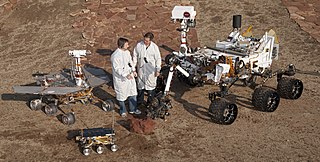Use cases
Mobile manipulation is a subject of focus in development and research environments. Mobile manipulators, either autonomous or remote operated, are used in many areas, such as space exploration, military operations, home care and health care. Within the industrial field, the implementation of mobile manipulators has been limited. The necessary technology entities (mobile platforms, robot manipulators, vision, and tooling) are, to a large extent, available from off-the-shelf components. [1]
Few implementations of mobile robots in the industrial field have been reported due to the center of attention being drawn on optimization of the individual technologies, especially robot manipulators [2] and tooling, [3] while the integration, use, and application have been neglected in the field of industrial mobile manipulation. This means that few implementations of mobile robots, in production environments, have been reported – e.g. [4] and. [5]

A robot is a machine—especially one programmable by a computer—capable of carrying out a complex series of actions automatically. A robot can be guided by an external control device, or the control may be embedded within. Robots may be constructed to evoke human form, but most robots are task-performing machines, designed with an emphasis on stark functionality, rather than expressive aesthetics.

A mobile robot is an automatic machine that is capable of locomotion. Mobile robotics is usually considered to be a subfield of robotics and information engineering.
Modular self-reconfiguring robotic systems or self-reconfigurable modular robots are autonomous kinematic machines with variable morphology. Beyond conventional actuation, sensing and control typically found in fixed-morphology robots, self-reconfiguring robots are also able to deliberately change their own shape by rearranging the connectivity of their parts, in order to adapt to new circumstances, perform new tasks, or recover from damage.
A virtual fixture is an overlay of augmented sensory information upon a user's perception of a real environment in order to improve human performance in both direct and remotely manipulated tasks. Developed in the early 1990s by Louis Rosenberg at the U.S. Air Force Research Laboratory (AFRL), Virtual Fixtures was a pioneering platform in virtual reality and augmented reality technologies.
Adaptable Robotics refers to a field of robotics with a focus on creating robotic systems capable of adjusting their hardware and software components to perform a wide range of tasks while adapting to varying environments. The 1960s introduced robotics into the industrial field. Since then, the need to make robots with new forms of actuation, adaptability, sensing and perception, and even the ability to learn stemmed the field of adaptable robotics. Significant developments such as the PUMA robot, manipulation research, soft robotics, swarm robotics, AI, cobots, bio-inspired approaches, and more ongoing research have advanced the adaptable robotics field tremendously. Adaptable robots are usually associated with their development kit, typically used to create autonomous mobile robots. In some cases, an adaptable kit will still be functional even when certain components break.
An agricultural robot is a robot deployed for agricultural purposes. The main area of application of robots in agriculture today is at the harvesting stage. Emerging applications of robots or drones in agriculture include weed control, cloud seeding, planting seeds, harvesting, environmental monitoring and soil analysis. According to Verified Market Research, the agricultural robots market is expected to reach $11.58 billion by 2025.

Robotics is the branch of technology that deals with the design, construction, operation, structural disposition, manufacture and application of robots. Robotics is related to the sciences of electronics, engineering, mechanics, and software.

Gerd Hirzinger received his Dipl.-Ing. degree and the doctor’s degree from the Technical University of Munich, in 1969 and 1974 respectively. In 1969 he joined DLR where he first worked on fast digital control systems. 1976 he became head of the automation and robotics laboratory of DLR, where he and his co-workers soon got several awards for innovative technology transfer from robotics research to applications. In 1991 he received a joint professorship from the Technical University of Munich, and in 2003 an honorary professorship at the Harbin Institute of Technology in China.

Robotics is the interdisciplinary study and practice of the design, construction, operation, and use of robots.

Open-source robotics is a branch of robotics where robots are developed with open-source hardware and free and open-source software, publicly sharing blueprints, schematics, and source code. It is thus closely related to the open design movement, the maker movement and open science.
The following outline is provided as an overview of and topical guide to robotics:
MiroSurge is a presently prototypic robotic system designed mainly for research in minimally invasive telesurgery. In the described configuration, the system is designed according to the master slave principle and enables the operator to remotely control minimally invasive surgical instruments including force/torque feedback. The scenario is developed at the Institute of Robotics and Mechatronics within the German Aerospace Center (DLR).

Robotnik Automation S.L.L. is a Spanish company that specializes in robot product development and robotics R&D projects. Robotnik is based in Valencia (Paterna) in Spain.
Masakatsu G. Fujie is a Japanese scientist who has played a major role in cutting-edge research in biomedical engineering. He has been responsible for many advances in the field of robotics.

Oussama Khatib is a roboticist and a professor of computer science at Stanford University, and a Fellow of the IEEE. He is credited with seminal work in areas ranging from robot motion planning and control, human-friendly robot design, to haptic interaction and human motion synthesis. His work's emphasis has been to develop theories, algorithms, and technologies, that control robot systems by using models of their physical dynamics. These dynamic models are used to derive optimal controllers for complex robots that interact with the environment in real-time.
Cloud robotics is a field of robotics that attempts to invoke cloud technologies such as cloud computing, cloud storage, and other Internet technologies centered on the benefits of converged infrastructure and shared services for robotics. When connected to the cloud, robots can benefit from the powerful computation, storage, and communication resources of modern data center in the cloud, which can process and share information from various robots or agent. Humans can also delegate tasks to robots remotely through networks. Cloud computing technologies enable robot systems to be endowed with powerful capability whilst reducing costs through cloud technologies. Thus, it is possible to build lightweight, low-cost, smarter robots with an intelligent "brain" in the cloud. The "brain" consists of data center, knowledge base, task planners, deep learning, information processing, environment models, communication support, etc.
The term “soft robots” designs a broad class of robotic systems whose architecture includes soft elements, with much higher elasticity than traditional rigid robots. Articulated Soft Robots are robots with both soft and rigid parts, inspired to the muscloloskeletal system of vertebrate animals – from reptiles to birds to mammalians to humans. Compliance is typically concentrated in actuators, transmission and joints while structural stability is provided by rigid or semi-rigid links.

Gregory D. Hager is the Mandell Bellmore Professor of Computer Science and founding director of the Johns Hopkins Malone Center for Engineering in Healthcare at Johns Hopkins University.
Sami Haddadin is a German electrical engineer, computer scientist, and university professor specializing in robotics and artificial intelligence. Since April 2018, he has served as the executive director of the Munich Institute of Robotics and Machine Intelligence (MIRMI) at the Technical University of Munich (TUM), where he also holds the Chair of Robotics and Systems Intelligence.
Robotics engineering is a branch of engineering that focuses on the conception, design, manufacturing, and operation of robots. It involves a multidisciplinary approach, drawing primarily from mechanical, electrical, software, and artificial intelligence (AI) engineering.














